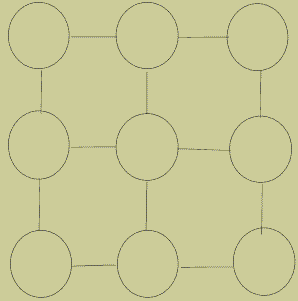The Classroom Package: Other Fun Stuff
The Classroom Package: Other Fun Stuff
... For example, Ecuadorian children play a different version of tick-tack-toe. Instead of using x's and o's, they use different colored beans or pebbles (or whatever is available). Each player gets only three. Instead of nine boxes, the playing board has nine circles, drawn as three parallel rows of three circles each, one row directly above the other (with spaces between each circle). The circles are connected to adjacent circles by single horizontal and vertical lines (but not diagonal lines) - to make four boxes with the circles in the corners of each box. Children usually draw the playing board on paper or in the ground.
After the board is ready and one player has been chosen to go first, the players take turns placing a bean in one of the circles, until all six beans are on the board (only one bean per circle). If one of the players has three beans in a row, he or she is the winner. If neither player has three in a row, the game continues. The players take turns moving their beans along lines to different circles until one player gets three in a row. Players can only move one bean at a time to adjacent circles along lines (no diagonal moves - only one move per turn.) It may take only a few moves or it may take several, but once a player gets three beans in a row, the game starts anew.
As you can see, this
game is very similar to the tick-tack-toe game you already know, only with
a little added strategy. Oh, and one last tip: in this version, if you try
to play on the blackboard, beware of gravity (or at least be prepared to counter
it).
Language Arts (Listening) Activity: Before students look at this section, explain to them that you're going to play a game like tick-tack-toe, but with a different board. Read them the description of the playing board and see if they can draw it (on paper) based on their listening skills. Here's what it looks like:

Math Connection: Have a tournament and, afterwards, discuss strategies and mathematical principles and terms (circles, squares, adjacent, diagonal, perpendicular lines, parallel lines, lines in a plane, alternating...). How many different rows of three could students form to win the game? How many different ways can the players place the beans on the board? How would the strategies and the possible outcomes change if the board had four rows of four circles, each player had four beans and the objective was to make rows of four. Try it!
Note: To avoid stalemates when playing, introduce time limits (~ ten seconds) and a rule that players can't continuously move back and forth between the same circles.
Gravity Factor
Science Discussion:
Gravity of course is a force, so if students play on the chalkboard, they'll
need to use another force to counter the force of gravity: magnetic force.
This is a good place to explore the topic of magnets and magnetic forces.
Get out the old iron filings! Discuss problems students would encounter
if gravity and/or magnetic forces were absent.
Amazon
Rain Forest |
The
Galapagos Islands |
| |